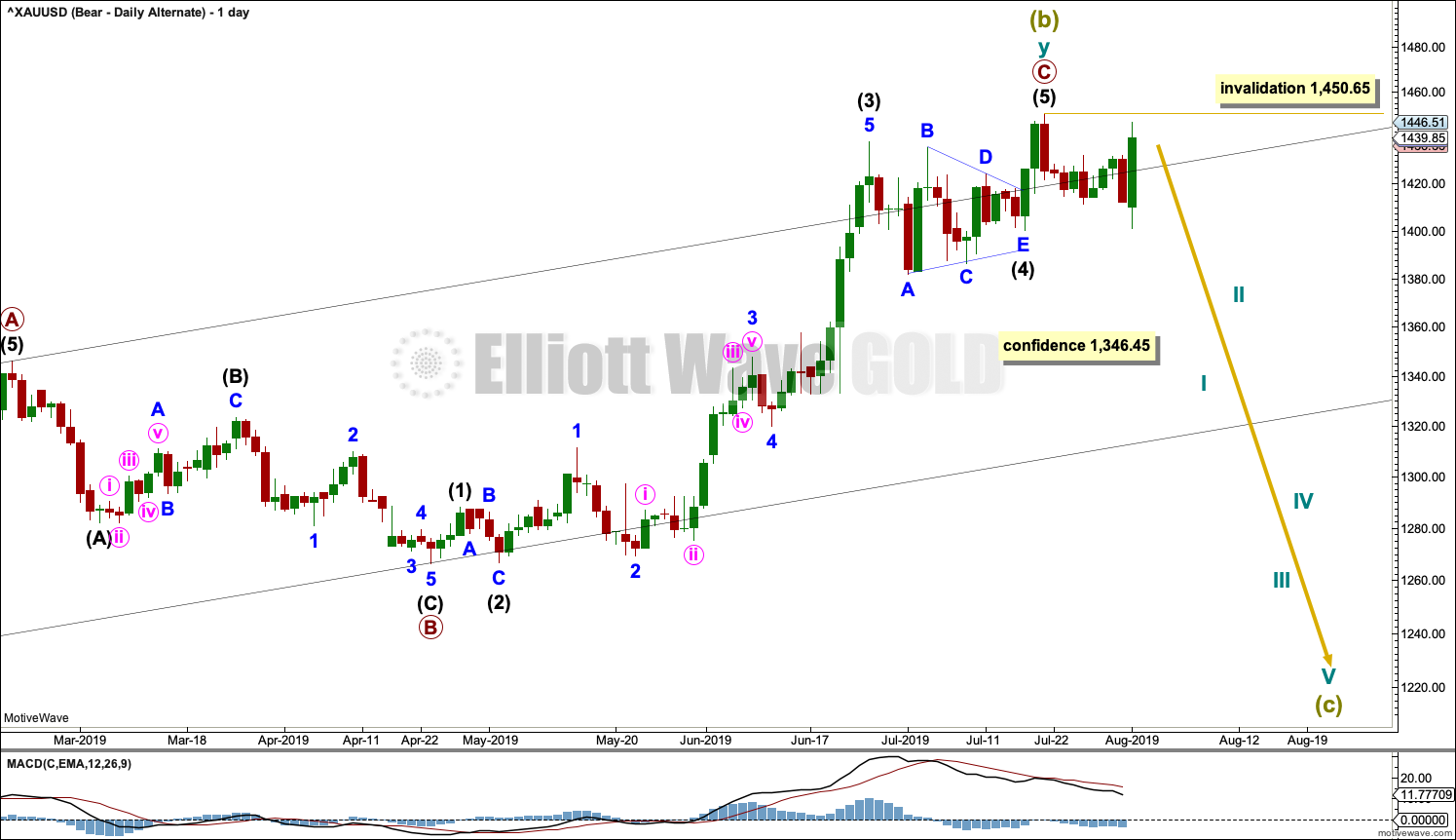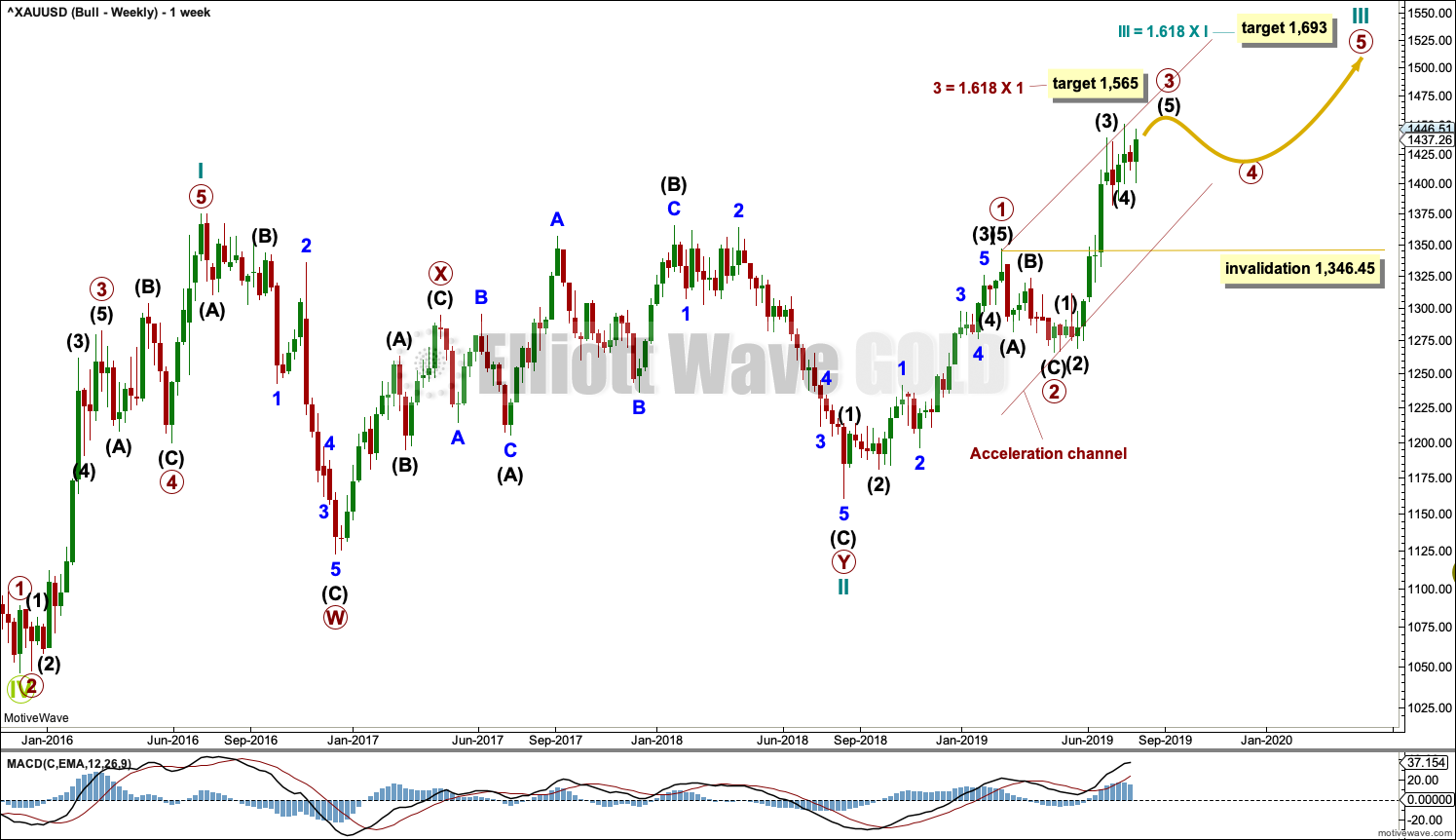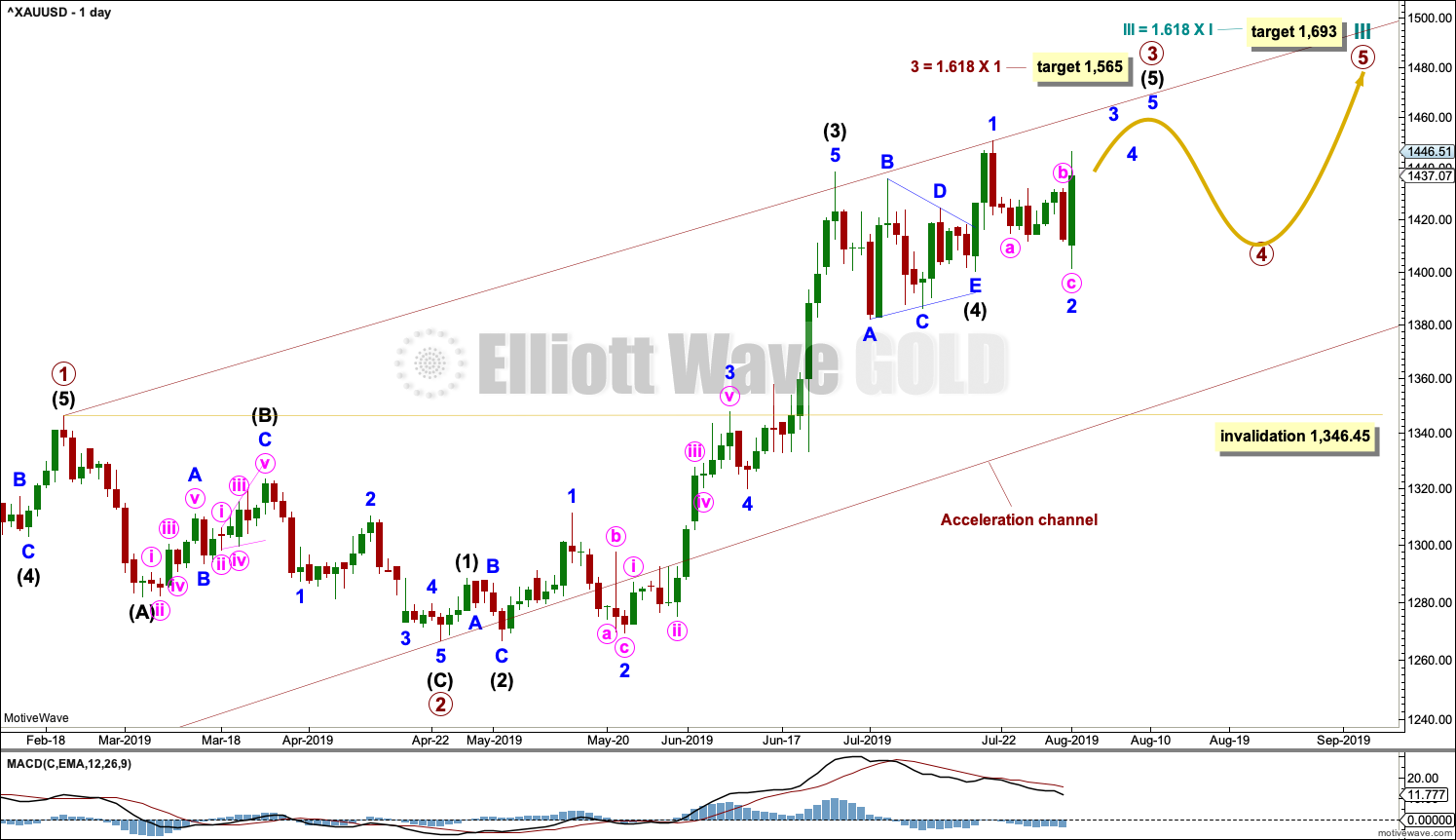The last two sessions have seen price whipsaw within a consolidation zone. Today On Balance Volume gives a reasonable signal. All Elliott wave counts remain valid.
Summary: There remains an upwards trend in place at the weekly chart level. With conditions extreme, a sideways consolidation may continue this week and possibly for another few weeks to relieve extreme conditions. This scenario favours the main bearish wave count. The final target for that count is 1,595. There is strong support below about 1,375.
The bullish Elliott wave count remains valid while price remans above 1,346.45. The mid-term target is 1,565.
Grand SuperCycle analysis is here.
Monthly charts were last published here with video here.
BEARISH ELLIOTT WAVE COUNTS
MAIN WEEKLY CHART
It remains possible that Super Cycle wave (b) is an incomplete double zigzag.
The first zigzag in the double is seen in the same way for both bearish wave counts, a zigzag labelled cycle wave w.
This main bearish wave count sees cycle wave x as regular contracting triangle. Cycle wave y must subdivide as a zigzag if Super Cycle wave (b) is a double zigzag. Within cycle wave y, primary wave A may now be complete, and primary wave B may not move beyond the start of primary wave A below 1,266.61.
Primary wave B may continue further for a few more weeks to relieve extreme conditions and complete a corrective Elliott wave structure.
MAIN DAILY CHART
Within cycle wave y, primary wave A may now be a complete five wave impulse.
Primary wave B may unfold over a few weeks. Primary wave B may subdivide as any one of more than 23 possible corrective Elliott wave structures. At this stage, it may be a time consuming sideways consolidation as a combination, flat or triangle.
Primary wave B should exhibit weakness.
Primary wave B may end about either the 0.382 or 0.618 Fibonacci Ratios. It may be relatively shallow if it finds support about 1,375, so the 0.382 Fibonacci ratio may be favoured as a target.
If primary wave B subdivides as any one of an expanded flat, running triangle or combination, then it may include a new high above its start at 1,450.65. A new high above this point does not invalidate this wave count at the daily chart level.
HOURLY CHART
At this stage, it looks likely that intermediate wave (A) within primary wave B may now be a complete zigzag. This may also be a zigzag for intermediate wave (W) of a double combination, or less likely, intermediate wave (W) of a double zigzag.
If primary wave B is subdividing as a flat correction, then within it intermediate wave (A) may now be a complete three. Intermediate wave (B) must now move higher as a three; at this stage, it looks like it may be unfolding as a zigzag. Intermediate wave (B) of a flat correction must retrace a minimum 0.9 length of intermediate wave (A). The most common type of flat is an expanding flat, which would require intermediate wave (B) to move beyond the start of intermediate wave (A) in order for it to reach a 1.05 length of intermediate wave (A) at 1,453.12 or above.
If primary wave B is subdividing as a triangle, then within it intermediate wave (A) may now be a complete zigzag. Intermediate wave (B) may move beyond the start of intermediate wave (A) above 1,450.65 as in a running triangle. Thereafter, a triangle would see sideways movement in an ever decreasing range for another one to very few weeks.
If primary wave B is subdividing as a double combination, then the first structure in the double may now be complete as a zigzag labelled intermediate wave (W). The double would then be joined by a three in the opposite direction, most likely a zigzag that may be incomplete and would be labelled intermediate wave (X). X waves within combinations are usually very deep and may make new price extremes beyond the start of wave W or Y. Thereafter, the second structure in a possible double combination may begin and move price sideways over another week to three as a flat correction or a triangle labelled intermediate wave (Y).
At this stage, primary wave B looks unlikely to be subdividing as a double zigzag because here this correction is unfolding sideways (double zigzag X waves are usually shallow and have a strong slope).
ALTERNATE WEEKLY CHART
This wave count is now judged to be an alternate. Small range days are not convincing as the start of a strong new downwards trend. However, this wave count remains valid.
It remains possible that a trend change at Super Cycle degree occurred on the 19th of July and a new downwards wave began there.
Double zigzags are common structures, but within them their X waves are almost always single zigzags that are relatively brief and shallow. However, this wave count sees cycle wave x as a complete double combination: zigzag – X – expanded flat.
An X wave may occasionally subdivide as a multiple. In a multiple the maximum number of corrective structures is three: W, Y and Z. To label any one of W, Y or Z as a multiple would violate the Elliott wave rule. Here, the rule is met.
Cycle wave y may be a complete zigzag. Within the zigzag, primary wave C is 5.19 short of equality in length with primary wave A.
The purpose of a second zigzag in a double zigzag is to deepen the correction when the first zigzag does not move price far enough. This purpose has been achieved.
A new low now by any amount at any time frame below 1,346.45 would invalidate the bullish wave count below and provide some confidence in a bearish wave count.
A new high by any amount at any time frame above 1,450.65 would invalidate this wave count.
ALTERNATE DAILY CHART
Primary wave C may now be a complete impulse.
Gold often exhibits surprisingly short and brief fifth waves out of its fourth wave triangles, and this wave count expects that it may have done so here. This wave count follows common tendencies for this market.
Super Cycle wave (c) should move below the end of Super Cycle wave (a) at 1,046.27 to avoid a truncation. Super Cycle wave (c) may only subdivide as a five wave structure, most likely an impulse. Within Super Cycle wave (c), no second wave correction may move beyond the start of its first wave above 1,450.65.
BULLISH ELLIOTT WAVE COUNT
WEEKLY CHART
This wave count sees the the bear market complete at the last major low for Gold in November 2015.
If Gold is in a new bull market, then it should begin with a five wave structure upwards on the weekly chart. However, the biggest problem with this wave count is the structure labelled cycle wave I because this wave count must see it as a five wave structure, but it looks more like a three wave structure.
Commodities often exhibit swift strong fifth waves that force the fourth wave corrections coming just prior and just after to be more brief and shallow than their counterpart second waves. It is unusual for a commodity to exhibit a quick second wave and a more time consuming fourth wave, and this is how cycle wave I is labelled. This wave count still suffers from this very substantial problem, and for this reason bearish wave counts are still considered above as they have a better fit in terms of Elliott wave structure.
Cycle wave II subdivides well as a double combination: zigzag – X – expanded flat.
Cycle wave III may have begun. Within cycle wave III, primary waves 1 and 2 may now be complete. If it continues lower as a double zigzag, then primary wave 2 may not move beyond the start of primary wave 1 below 1,160.75.
Cycle wave III so far for this wave count would have been underway now for 50 weeks. It may be beginning to exhibit some support from volume and increasing ATR. If this increase continues, then this wave count would have some support from technical analysis.
Draw an acceleration channel about primary waves 1 and 2: draw the first trend line from the end of primary wave 1 to the last high, then place a parallel copy on the last high. Keep redrawing the channel as price continues higher. When primary wave 3 is complete, then this channel would be drawn using Elliott’s first technique about the impulse. The lower edge may provide support.
Primary wave 4 may not move into primary wave 1 price territory below 1,346.45. Because the data used for this analysis is cash market data no overlap between primary waves 4 and 1 should be allowed. The invalidation point is absolute.
DAILY CHART
Primary wave 3 may only subdivide as an impulse. Within the impulse, intermediate waves (1) through to (4) are all now complete. It is possible that intermediate wave (5) could be over at the last high, but for this wave count it would look more normal if it continued higher.
When it arrives, then primary wave 4 may not move into primary wave 1 price territory below 1,346.45.
On the hourly chart, extend the trend lines from the triangle of intermediate wave (4) out to the right. The upper B-D trend line has provided support.
HOURLY CHART
Intermediate wave (5) may only subdivide as a five wave structure, either an impulse or an ending diagonal. Fifth waves to end third waves one degree higher, as this one is, almost always subdivide as impulses (that is what shall be expected).
Within intermediate wave (5), minor waves 1 and 2 may now both be complete.
The triangle trend lines that have been extended out from the intermediate wave (4) triangle crossed over exactly at the point which saw a strong trend change. This was mentioned in yesterday’s analysis as a possibility to be prepared for.
Minor wave 3 may only subdivide as an impulse. Within minor wave 3, minute wave i may now be complete and minute wave ii may move lower as a zigzag. Minute wave ii may end about either the 0.382 or 0.618 Fibonacci Ratios. The 0.382 Fibonacci ratio may be favoured as the upwards pull of a third wave at minute and minor degrees may force minute wave ii to be more shallow.
When minute wave ii looks like a three wave structure on the hourly chart, then look out for an increase in upwards momentum and an upwards breakout from the consolidation zone.
Minute wave ii may not move beyond the start of minute wave i below 1,401.30.
TECHNICAL ANALYSIS
MONTHLY CHART

Click chart to enlarge. Chart courtesy of StockCharts.com.
Gold has effected an upwards breakout above multi-year resistance and above the cyan bear market trend line. Look for next resistance identified on the chart.
The new high in price above prior highs for March / April 2018 have not been matched by new highs for On Balance Volume. This divergence is bearish and supports a bearish Elliott wave count. This divergence may be given a little weight because it is strong and evident on the monthly chart.
WEEKLY CHART

Click chart to enlarge. Chart courtesy of StockCharts.com.
A new high two weeks ago exhibits some bearish divergence between price and RSI. However, as has been seen recently, sometimes this divergence simply disappears.
The bottom line remains that a multi year breakout occurred a few weeks ago, and it occurred with strength in volume. While price remains above support about 1,377 and ADX indicates an upwards trend, this chart will remain overall bullish.
DAILY CHART

Click chart to enlarge. Chart courtesy of StockCharts.com.
Stockcharts data sees a new high today, but price has closed well back within the consolidation zone. There has been no upwards breakout today.
Today completes an inconclusive day, despite strong upwards movement on the hourly chart. The candlestick is an outside day that completes as a Spinning Top. This is on its own a neutral candlestick pattern indicating a balance of bulls and bears. The balance of volume was downwards although the candlestick has closed green.
Because today’s candlestick is neutral and price remains within the consolidation zone, give weight to the bearish signal today from On Balance Volume. Look out for a possible surprise to the downside. This supports the bearish Elliott wave counts.
The prior upwards trend reached very extreme; there, RSI reached overbought and then exhibited bearish divergence with price. Either a consolidation to relieve extreme conditions or a trend change may reasonably be expected to follow.
GDX WEEKLY CHART

Click chart to enlarge. Chart courtesy of StockCharts.com.
The bearish candlestick reversal pattern last week indicates a potential trend change.
Candlestick reversal patterns make no comment on the direction of the new trend (a full 180 degree reversal or sideways) nor for how long it may last. This reversal pattern may indicate a consolidation to unfold here, or it may indicate a new downwards trend.
Strength or weakness in the next one to very few weeks may indicate which scenario may be preferred.
GDX DAILY CHART

Click chart to enlarge. Chart courtesy of StockCharts.com.
Price remains range bound and is whipsawing within a consolidation zone. Resistance is about 28.50 and support about 26.40. A close outside of this zone is required to indicate the next direction.
A new swing low below 24.53 would confirm a trend change.
Published @ 09:36 p.m. EST.
—
Careful risk management protects your trading account(s).
Follow my two Golden Rules:
1. Always trade with stops.
2. Risk only 1-5% of equity on any one trade.
—
New updates to this analysis are in bold.









Hourly bear chart updated:
A zigzag higher for intermediate (B) or (X) may be close to completion.
Hourly bull chart updated:
An upwards breakout may happen Monday for this count.
Closed all my Golds today …
Monday could be crunch time … What’s the signal to go long or short ?
I have decided to start a short selling program on gold/silver and I’ve covered my short DJI and crude positions. Gold could start a C wave down any second.
I don’t like action in crude on short side, and the dow has already hit my min downside targets…although could go another 500 pts down, I already captured 700 of it thanks to a tweet.
I tend to agree with you, C.
Not much strength in Gold at this second … It’s not ready for that push high (in my opinion)